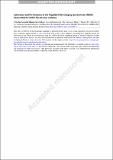| dc.contributor.author | Hong, Jaesub | |
| dc.contributor.author | Binzel, Richard P. | |
| dc.contributor.author | Allen, Branden | |
| dc.contributor.author | Guevel, David | |
| dc.contributor.author | Grindlay, Jonathan | |
| dc.contributor.author | Hoak, Daniel | |
| dc.contributor.author | Masterson, Rebecca | |
| dc.contributor.author | Chodas, Mark | |
| dc.contributor.author | Lambert, Madeline | |
| dc.contributor.author | Thayer, Carolyn | |
| dc.contributor.author | Bokhour, Ed | |
| dc.contributor.author | Biswas, Pronoy | |
| dc.contributor.author | Mendenhall, Jeffrey A. | |
| dc.contributor.author | Ryu, Kevin | |
| dc.contributor.author | Kelly, James | |
| dc.contributor.author | Warner, Keith | |
| dc.contributor.author | Lim, Lucy F. | |
| dc.date.accessioned | 2021-11-18T15:35:24Z | |
| dc.date.available | 2021-11-18T15:35:24Z | |
| dc.date.issued | 2021-11-17 | |
| dc.identifier.uri | https://hdl.handle.net/1721.1/138155 | |
| dc.description.abstract | Abstract
The REgolith X-ray Imaging Spectrometer (REXIS) instrument on board NASA’s OSIRIS-REx mission to the asteroid Bennu is a Class-D student collaboration experiment designed to detect fluoresced X-rays from the asteroid’s surface to measure elemental abundances. In July and November 2019 REXIS collected ∼615 hours of integrated exposure time of Bennu’s sun-illuminated surface from terminator orbits. As reported in Hoak et al. (Results from the REgolith X-ray Imaging Spectrometer (REXIS) at Bennu, 2021) the REXIS data do not contain a clear signal of X-ray fluorescence from the asteroid, in part due to the low incident solar X-ray flux during periods of observation. To support the evaluation of the upper limits on the detectable X-ray signal that may provide insights for the properties of Bennu’s regolith, we present an overview of the REXIS instrument, its operation, and details of its in-flight calibration on astrophysical X-ray sources. This calibration includes the serendipitous detection of the transient X-ray binary MAXI J0637-430 during Bennu observations, demonstrating the operational success of REXIS at the asteroid. We convey some lessons learned for future X-ray spectroscopy imaging investigations of asteroid surfaces. | en_US |
| dc.publisher | Springer Netherlands | en_US |
| dc.relation.isversionof | https://doi.org/10.1007/s11214-021-00853-4 | en_US |
| dc.rights | Creative Commons Attribution-Noncommercial-Share Alike | en_US |
| dc.rights.uri | http://creativecommons.org/licenses/by-nc-sa/4.0/ | en_US |
| dc.source | Springer Netherlands | en_US |
| dc.title | Calibration and Performance of the REgolith X-Ray Imaging Spectrometer (REXIS) Aboard NASA’s OSIRIS-REx Mission to Bennu | en_US |
| dc.type | Article | en_US |
| dc.identifier.citation | Space Science Reviews. 2021 Nov 17;217(8):83 | en_US |
| dc.contributor.department | Lincoln Laboratory | |
| dc.contributor.department | Massachusetts Institute of Technology. Department of Earth, Atmospheric, and Planetary Sciences | |
| dc.contributor.department | Massachusetts Institute of Technology. Department of Aeronautics and Astronautics | |
| dc.contributor.department | MIT Kavli Institute for Astrophysics and Space Research | |
| dc.eprint.version | Author's final manuscript | en_US |
| dc.type.uri | http://purl.org/eprint/type/JournalArticle | en_US |
| eprint.status | http://purl.org/eprint/status/PeerReviewed | en_US |
| dc.date.updated | 2021-11-18T04:34:53Z | |
| dc.language.rfc3066 | en | |
| dc.rights.holder | The Author(s), under exclusive licence to Springer Nature B.V. | |
| dspace.embargo.terms | Y | |
| dspace.date.submission | 2021-11-18T04:34:53Z | |
| mit.license | OPEN_ACCESS_POLICY | |
| mit.metadata.status | Authority Work and Publication Information Needed | en_US |
